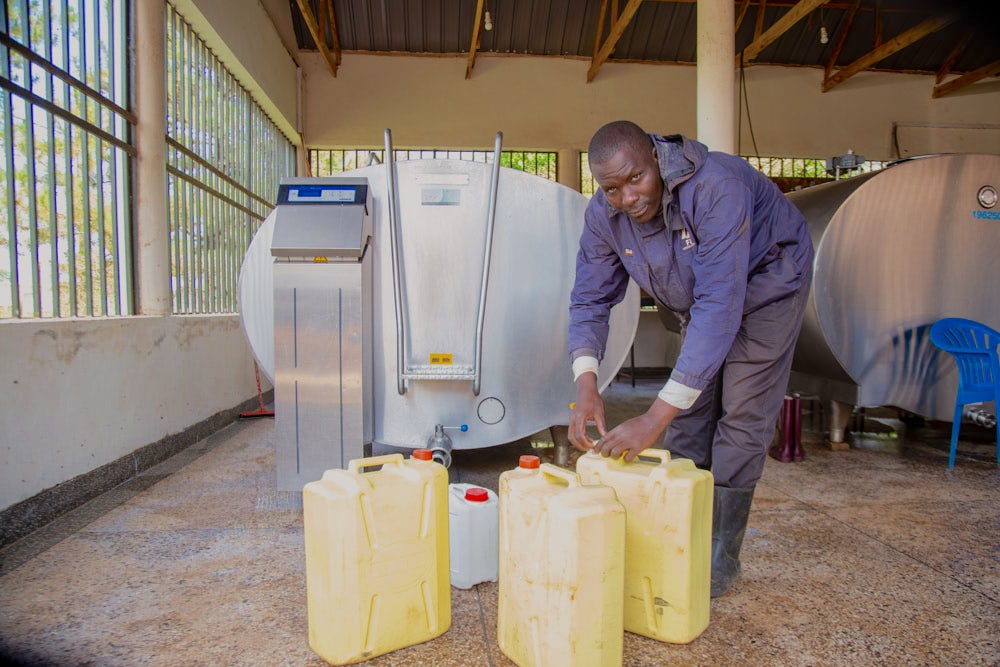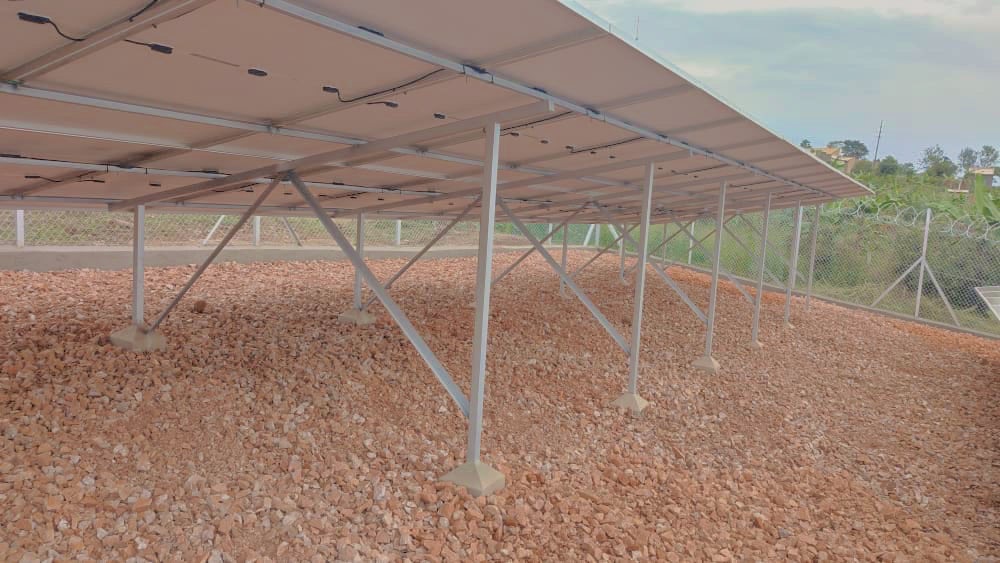Dairy production in Uganda is dominated by rural smallholder farmers. The dairy sector currently represents 6.5 percent of the country's agricultural gross domestic product and dairy production is reported by the Dairy Development Authority of Uganda (DDA) to be a major activity in the cattle corridor, a stretch of rangeland covering more than a third of the country.
.jpg?or=0&q=60&crop=faces,entropy&auto=format&fm=jpeg&shad=50&vib=20&duotone-alpha=40&duotone=000000,2CFFD4C6&w=1000)
Given its predominance in rural areas, dairy farming contributes significantly to rural communities' economic, nutritional and employment opportunities, making the dairy sector a worthy investment for developing agribusiness in Uganda.
Heifer International thus chose to support Uganda’s dairy farming sector to address the challenges that contribute to limited milk production and render dairy farmers vulnerable, including access to energy, which we consider a key variable for enabling dairy farmers to earn a living income.
According to the World Bank, only 28 percent of Uganda’s population had access to electricity in 2018. This lack of access has significant implications for economic development and quality of life, as it limits opportunities for businesses and makes it difficult for individuals to access basic services like healthcare and education.
For dairy farmers, a lack of electricity makes it difficult to keep milk chilled, and many rely on diesel generators, which emit high volumes of carbon and are expensive to maintain.
To address this challenge, Heifer International has partnered with Carbon Trust under the Powering Renewable Energy Opportunities (PREO) program to implement the Solar for Sustainable Income in Dairy project to provide alternative power, specifically solar-powered rural milk chilling solutions, at the dairy cooperative level across Uganda.
.jpg?or=0&q=60&crop=faces,entropy&auto=format&fm=jpeg&shad=50&vib=20&duotone-alpha=40&duotone=000000,2CFFD4C6&w=1000)
The first to benefit from the project was Migina Milk Collection Centre, a satellite milk bank for Dwaniro Dairy and Livestock Farmers Cooperative Limited in Kiboga district, Central Uganda. The cooperative has a total of 821 milk suppliers, of which 468 are members, as of December 2023. These farmers supply the cooperative with milk daily and, in turn, attain a market for their milk through the milk processing companies that purchase milk in bulk from the collection center.
Heifer officially commissioned a 41.4 kilowatt-peak (kWp) photovoltaic (PV) solar system for the Migina Milk Collection Center in August 2023.
Before the solar system was installed, the cooperative relied on generators as its source of power and, as a result, used to spend $30,000 annually on servicing, maintaining and fueling the machines. The unreliability of the generators and high maintenance fees resulted in high operating costs for the cooperative — and, in turn, lower prices offered to farmers for their milk.
“Generators are serviced by technicians outside the operational areas. The time lag between generator troubleshooting activities led to milk losses worth $2,500 in spoilage,” said Edna Nyamwaka, Heifer project manager, referring to the cooperative’s substantial monthly losses.
“The reliable source of power results in good quality milk, which fetches a good market price from the off-taker [buyer]. This, in turn, enables the cooperative to pay farmers well.” — Heifer Project Manager Edna Nyamwaka
With sufficient and reliable solar power, Dwaniro Dairy and Livestock Farmers Cooperative Limited has reduced milk losses at Migina Milk Collection Centre to zero.
According to Steven Kawooya, production and marketing manager for the cooperative, 197,321 liters of milk worth $49,682 are now chilled monthly, and the cooperative has reduced its power costs to $18,170 a year.
“With this initiative, and with less losses made by the cooperative, the farmers save up to 46 percent of what they earn from milk sales,” he said, explaining how dairy farmers who sell to the solar-powered milk collection center are now earning a higher price per liter than they were before.

In December 2023, a second solar power system was commissioned for Nabitanga Dairy Cooperative located in Ssembabule District, Central Uganda, and in February 2024, a third solar system was commissioned for Kiryanyonza Milk Collection Centre, a second satellite milk bank for Dwaniro Dairy and Livestock Farmers Cooperative Limited.
With these in place, the cooperatives are expecting savings resulting from less milk spoilage and eliminating the expenses of generator fuel and maintenance, along with less carbon emissions from generator use, creating efficiency, a clean environment, safer and cleaner milk, and more volumes of milk collected for sale.
“Milk prices fluctuate,” said Edna. “In the wet season prices are low, and dry season prices are high. The reliable source of power results in good quality milk, which fetches a good market price from the off-taker [buyer]. This, in turn, enables the cooperative to pay farmers well.”
.jpg?or=0&q=60&crop=faces,entropy&auto=format&fm=jpeg&shad=50&vib=20&duotone-alpha=40&duotone=000000,2CFFD4C6&w=1000)
Successes and learnings from the first two solar installations have attracted more funding and partnership opportunities to expand the Solar for Sustainable Income in Dairy project.
In part with new support from aBi Development Limited, a Uganda-based provider of agriculture grants and business development services, Heifer International plans to put in place two more solar installations — for Kiboga Livestock Cooperative in Kiboga District, Central Uganda, and Kijjumba Dairy Cooperative in Nakaseke District, Central Uganda — by June 2024.
Additionally, with 30 percent co-financing from Heifer International, Heifer Uganda is leveraging 70 percent commercial financing from the Uganda Development Bank and Centenary Bank through the Ugandan government's Agricultural Credit Facility, a fund dedicated to agriculture-related investments, to finance three more solar installations by December 2024.
The Solar for Sustainable Income in Dairy project works in alignment with the government’s objective to power the entire country by 2030, including with solar solutions; the Ministry of Energy and Mineral Development recently received a grant worth $35 million from the German government and the European Union to support the electrification of Uganda’s rural areas with solar energy and contribute to the transition to clean renewable energy.

By bringing solar power closer to farmers, Heifer Uganda is contributing to this mission.
Going forward, the project intends to scale up operations by conducting feasibility studies to design optimal solar solutions for other Heifer-supported dairy cooperatives. The project will also support technology providers and financiers to design appropriate business models for financing the installations.
Amidst global energy challenges, the sun offers bright solutions. See how Heifer is leading the charge with other sustainable projects.
